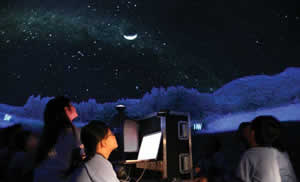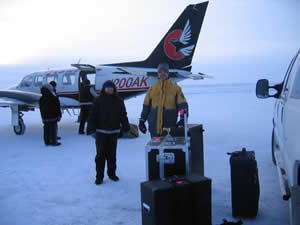NASA grant sends digital planetarium to rural Alaska
NASA grant sends digital planetarium to rural Alaska
Submitted by Kerynn Fisher
Phone: 907-474-6941
11/14/08


With help from a $488,000 NASA grant, the University of Alaska Museum of the North and scientists at the UAF Geophysical Institute are joining forces to bring the state’s only digital portable planetarium to communities in rural Alaska.
Project organizers Robert Herrick, a research associate professor in planetary sciences, and Laura Conner, museum education director, hope the traveling planetarium show and related community activities will inspire students, particularly Alaska Native students, to choose careers in science and engineering.
"Rural Alaska represents a region that’s underserved in terms of science education," says Conner. "This project fits perfectly with NASA’s educational mission to inspire students, particularly in earth and space sciences."
The grant will support the development of an Alaska-specific planetarium program and "NASA Days" in rural communities over the next three years. The "NASA Days" will include planetarium shows for schoolchildren designed to illustrate grade-specific space science concepts; workshops for local teachers that will provide educational materials and activities to be used throughout the school year; and an evening community science night with planetarium shows and activities highlighting current NASA research. As much as possible, the programs will relate NASA research to conditions in Alaska and to Geophysical Institute research - for example, comparing arctic sea ice to the ice on Jupiter’s moon, Europa, or comparing permafrost and polygonal formations in arctic Alaska to those on Mars.
The digital portable planetarium, purchased by UAF in 2007 with funding from BP and ConocoPhillips, is key to the science outreach program. The Digital STARLAB projection system and its 4-meter and 6-meter diameter domes can be easily transported as checked luggage or by small plane to more remote communities and set up in venues ranging from school gymnasiums to small community centers. It is the only system of its type in Alaska.
"The system is very versatile. It allows us to see the night sky from different perspectives or even to travel to different parts of the galaxy," says Herrick. "We can also incorporate photos and videos into the program to illustrate different concepts."
Herrick will work with museum staff to develop scripted programs that draw on existing software for digital planetariums while incorporating Alaska analogues. Ultimately, both Herrick and Conner hope to incorporate Alaska Native knowledge and elders’ stories about the night sky and planetary phenomena to give the planetarium shows even more Alaska context.
The program concept was tested this spring, both in Fairbanks and in the North Slope communities of Barrow and Nuiqsut this spring. The response to the pilot programs was universally positive. Herrick and Conner hope to take the program to another 50 communities, many of them off the road system, beginning in late spring 2009. A project outreach coordinator will work with UAF’s College of Rural and Community Development and local school districts to identify community hosts and potential venues. Communities interested in scheduling a "NASA Day" can contact the museum at 907-474-5360 or email museum.education@uaf.edu.
The Barrow Arctic Science Consortium, Challenger Center of Alaska in Kenai and the University of Alaska Geography Program are also partners on the project.
CONTACT: Kerynn Fisher, University of Alaska Museum of the North communications coordinator, at 907-474-6941 or 907-378-2559.


